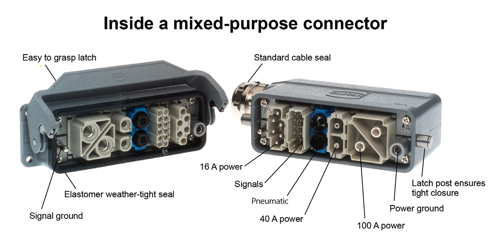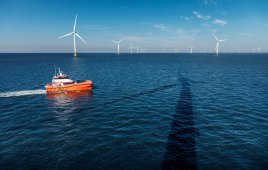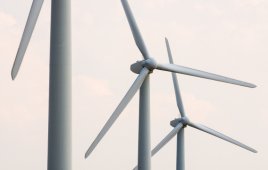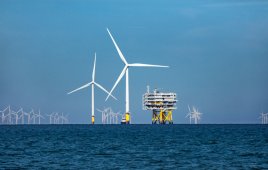Robert Laskowski, Harting North America, Elgin, Ill, www.harting.com
Wind turbine systems encompass a wide variety of components and subsystems that must be integrated and tested. The work requires several types of wiring and cables for electrical power, data communications, and control signals. In the nacelle, cabling is essential to connect generators, their slip rings, inverters, pitch and yaw controls, and more. Before shipping, a wind-turbine manufacturer typically assembles and tests most of the systems that often come from many different companies. Lastly, the nacelle, tower, and base-control station are assembled on site where final electrical connections are made.
Point-to-point wiring
The practice of using point-to-point cabling (hardwiring) between major subsystems and assemblies has traditionally been problematic. This type of wiring typically runs through rigid or flexible conduit. Even if conduit is not used, it can make electrical assembly work at the plant inefficient and expensive. In any case, it complicates the testing, troubleshooting, and debugging of major system elements. The same is true at the jobsite when the entire wind turbine is assembled and hardwiring errors are likely–particularly when independent contractors are not experienced with the brand of turbine they’re installing. The problems multiply in a tower installation, which includes a turbine-control center (base station), data-communication system, internal and collision-warning light systems, and may also involve power and control wiring for a service lift.
Direct and indirect costs associated with hardwiring problems can be substantial. In addition to the direct-labor costs of point-to-point wiring, similar costs are incurred to disassemble the system prior to shipping. When problems surface during testing in the plant, troubleshooting often involves disconnecting wires at terminal points to isolate the problems.
The situation is not much different when a system is reassembled at the jobsite. In a worst-case scenario, equipment can be damaged during start-up due to wiring errors. Particularly difficult problems may require calling out factory engineers and technicians to correct the situation, which entails travel time and expenses, start-up delays, and cost overruns. These events can lead to unpleasant customer confrontations, damaged relations – even lawsuits.
Better ideas
Industrial engineers who have studied the problem say a solution is to first consider installation as part of manufacturing. In fact, the entire turbine and tower should be designed for manufacturing.
When looking at electrical systems, designers envision cables terminated in connectors for easy assembly and disassembly. Many of these cables have only one type of conductor and uniform contacts, such as those for power, data communications, or control signals. In contrast, a wind turbine installation has a lot of different types of wiring. This would seem to require many different connectors and individual cable assemblies. However, recent developments in connector technology are making that thinking obsolete.
Today, modular connectors sport capabilities that allow hybrid (mixed purpose) connectors. Thus, engineers can create customized connectors to accommodate optical fiber, Ethernet, coax, pneumatic lines, electric power, and many other specialized connections. These connectors let mixed-use cable assemblies replace point-to-point wiring.
At first, this might seem counter-intuitive to the idea of simplifying system wiring, but it’s not. Such cables are easy to assemble with crimp, screw, cage clamp, and axial screw wire terminations, and their automated testing quickly ensures there are no wiring errors. If wiring errors are found, connector wires are easy to remove and replace. The result is a prewired, pre-tested, known-good cable assembly for interconnecting major parts of a wind turbine.
At the equipment end of a pre-assembled cable, wiring fan-outs go to various wind-turbine subassemblies. The fan-outs could be wires with individual connectors, such as those used for screw terminals. Alternatively, the fan-outs could use other multi-conductor connectors to mate with those on the subassemblies.
The figure Comparing hardwire to connectors, is a simple block diagram showing wiring fan-outs inside the boxes that represent wind-turbine subassemblies at the ends of a cable run. Fan-outs are typical for connections to a panel board. Cable connectors simplify attachments for assembly and disassembly during the wind turbine construction phase, and make troubleshooting much easier if there are problems.
Cost-to-benefit ratio
Although adding connectors adds cost to a cable run, it brings advantages such as:
• Standardizes (makes more efficient) engineering, design, and assembly tasks
• Eliminates use of rigid conduit
• Reduces panel clutter for a “cleaner” design
• Quickens disassembly for shipping
• Lowers installation wiring costs and start-up time at the jobsite
• Minimizes need for factory personnel at installation• Reduces downtime for maintenance and repairs
• Reduces maintenance inventory with standardized cables and connectors
• Lowers warranty costs
• Eases modifications with upgrades and options in the field
• Greater customer satisfaction
To expand on a few of these points, the reduction in initial wiring cost derives from staged subsystem and electrical panel assembly with pre-wired and tested cable assemblies. Testing and debug time drops because it’s easier to isolate and test individual components by removing cables with connectors. System design is modularized because of standardized, pre-built subassemblies. Using connectorized-cable assemblies provides a “plug and play” start-up for much of the wind turbine. Customer satisfaction is greater because of reduced start-up problems and lower service costs after installation. Routine maintenance and many repairs become less difficult because many components and subsystems are “plugged-in” versus “wired-in”.
Although payback from many of the benefits is difficult to quantify, it is possible to make reasonable estimates and compare the labor costs of hardwiring versus connectorized cabling at the factory. Such a comparison is shown conceptually in A comparison of concepts.
A few figures
More quantitative information comes from experience in the application of connectors to replace hard wiring. In the case of wind-turbine systems, a rule-of-thumb for fully burdened hard wiring labor costs is $80 for both ends of a single cable run. For the initial installation of connectors on each end of the same cable, experience shows there is 40% added cost for connector wiring, plus the cost of the connectors. Two connectors typically costing $60, bring the initial connectorizaton cost to $60 + 1.4 x $80 = $172 at the wind-turbine manufacturer’s plant.
However, our field experience shows there is about a 30% premium on field wiring labor costs compared to the same hard wiring done in the plant. Assuming that major assemblies are shipped to the jobsite fully assembled, this means that hard-wired cables must be disconnected in the field, and then reconnected for installation. Therefore, the total installation cost for a single hard-wired cable at the jobsite is $80 x 2 x 1.3 = $208.
Because the cost of unplugging and replugging two connectors on a cable is negligible, this brings a net savings from connectorization of $208–$92 = $116. Any subsequent disconnecting and reconnecting required due to field-wiring errors and troubleshooting will generate additional savings from connectorized cables.
Each case will be different, but clients have run their own numbers and come to similar conclusions. In fact, they have calculated saving thousands of dollars from actual equipment installations.
If there were no problems associated with a hardwired installation, and there was no premium on field-labor costs, using a connectorized cable would at least be close to a break-even proposition. Thereafter, routine maintenance and troubleshooting problems bring future savings.
Recent developments in hybrid and modular connector technology circumvent many of the manufacturing, installation, and service problems associated with wind turbines. In most cases, the use of connectorized cabling lowers the overall cost of a wind turbine while increasing customer satisfaction.
WPE
Filed Under: Cables & connectors, O&M, Turbines







An alternative to a wind turbine split ring is a simple plug connector positioned at the bottom of the wind turbine mast
more information:http://www.moflon.com